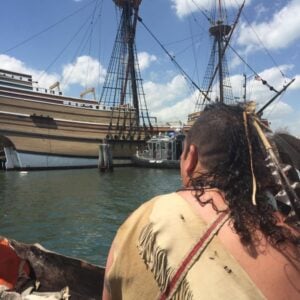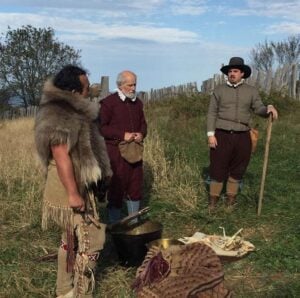Prior to my career at American Ancestors, I worked at the living history museum called Plimoth Plantation (now referred to as Plimoth Patuxet). For five years, I had the remarkable opportunity of learning and telling the story of the Pilgrims and Wampanoag Natives. I first started in the Group Sales Office, where we assisted school and tour groups with their planned visits to Plimoth Plantation. Throughout the fall season, we could accommodate up to 2,500 children per day. After about a year, I was promoted to work in the Education department and was responsible for scheduling all the programs offered through the interpretation staff – off-site classroom visits, workshops, overnights at Plimoth Plantation, and summer and winter day camps. In this role, I learned to love the seventeenth century.
Every March, Plimoth Plantation holds an intense two-week training for all their interpretation staff. This training involves presentations that range from the history of 1620 to the relationships between Colonists and the Natives, and even the tensions that lingered up to and during King Philip’s War. Readings were recommended and dialect coaching was a big part of becoming immersed in the period. During the winter of 2015, I expanded my knowledge to encompass Native culture, too.
Books like William Bradford’s Of Plimoth Plantation only skim the surface of Native life in seventeenth century. Personally, I had the good fortune to learn directly from Native peoples and those employed by Plimoth Plantation: Wampanoag, Cherokee, Abenaki, and Narragansett Natives who are instilled with oral traditions and native culture from birth.
Throughout the next few years, I gained something of an understanding of the Native population. This understanding allowed me to work on the Wampanoag Homesite a few times. I was honored with the task of introducing visitors to the Homesite at the start of their visit to Plimoth Plantation. I always started my introduction with two rules of the Homesite:
(1) open your mind to learn and explore; and
(2) the people you will meet today are Native and they are telling you the story of their ancestors, who once lived on this land – be kind and listen.
When I had the chance to visit (or work) on the Homesite, I reveled in the history that surrounded me in Patuxet: the smells, the sights, and, above all, the people who tirelessly told their story to visitors. But it was the “behind-the-scenes” moments that I think back upon often: the cardinals, the ceremony, and my white privilege.
When I had the chance to visit (or work) on the Homesite, I reveled in the history that surrounded me in Patuxet...
In some cultures, when you see a cardinal flying nearby, it means that your ancestors are coming from their world to visit. A fellow co-worker used to leave food for his ancestors and would often have a prayer before work to honor them each day. When I see a cardinal today, it makes me think of my ancestors who have paved the way for me. Ironically, I have four birds tattooed on my arm to signify my four grandparents.
My most memorable experience was when our staff came together in the nushwetu (house with three fires) to celebrate the life of a co-worker who had passed away. The death rituals of Native peoples are often closed to outsiders, but we were family and we had lost one of our own. The stillness, the smell of tobacco, the togetherness of this ceremony will hold a special place in my heart for the rest of my life.
 And, lastly, the words we have been hearing a lot lately – white privilege.
And, lastly, the words we have been hearing a lot lately – white privilege.
I was fully aware of my white privilege while working at Plimoth Plantation. I am a college graduate. I have blue eyes and blonde hair, and my ancestors came to New France (Canada) – most having a large part of the colonization of the Indigenous people of the Eastern Woodlands.
Please believe me when I say that I do not speak for Native peoples – but I do have the passion to educate others to respect their way of life, their oral traditions, and their culture. I think that’s important to understand today in 2020, which happens to be the 400th year of the Pilgrims landing in Patuxet. Native peoples are still here and have cared for the land for centuries. Most recently, Wampanoag Nation was fighting for reservation as trust land in Massachusetts (Bill H.R.312), which would have removed funding for their clean water program, children’s education through the Mukayuhsak Weekuw immersion programs, emergency services, and housing and substance abuse programs. Thankfully, in July 2020, the U.S. House of Representatives passed H.R. 7608 – a package of appropriations bills – that includes an amendment that protects the land of the Mashpee Wampanoag Tribe. #istandwithmashpee
When discussing this blog post with a friend, I was reminded of the connection that I established through my work at Plimoth Plantation. Timothy Turner, who is of Cherokee Nation and the current Indigenous Culture and History Associate at Plimoth Patuxet, is one of many who contributed to my passion for learning. Tim says, “As a native person, it is important to continue to keep traditions alive and teach others about Native culture. From burning out a mishoon, making a bow, constructing a house, and then passing that knowledge onto the next generation – it’s our story and it needs to live on.”
Books worth adding to your collection:
This Land Is Their Land: The Wampanoag Indians, Plymouth Colony, and the Troubled History of Thanksgiving by David J. Silverman
Our Beloved Kin by Lisa Brooks
Every little bit helps:
Support Indigenous Peoples: https://novofoundation.org/supporting-indigenous-communities-in-north-america/
Mashpee Wampanoag Nation: https://mashpeewampanoagtribe-nsn.gov/
Wôpanâak Language Reclamation Project: https://www.wlrp.org/ways-to-help
Visit Plimoth Patuxet and support their mission: https://plimoth.org/
A Bridge to the Past: Native Peoples of the Northeast Woodlands and Coat Exhibit Building https://inspire.plimoth.org/a-bridge-to-the-past/
Share this:
About Sarah Dery
Sarah Dery, who lives in Concord, is the Research and Library Manager at American Ancestors/NEHGS; she has been with the Society since 2017. She supports the researchers and genealogists on the Research and Library teams, managing correspondence with constituents, organizing research information, and applying her genealogical knowledge in assisting our clients – both in-person and digitally. Sarah is a graduate of Rhode Island College in Providence and has a B.A. in anthropology and English Literature. Her interest in anthropology stems from her participation in a week-long archaeology dig at James Madison’s Montpelier in Virginia. Her family ancestry and expertise include Rhode Island, Connecticut, and French-Canada.View all posts by Sarah Dery →
